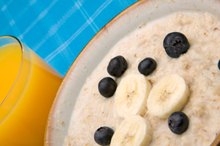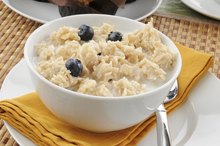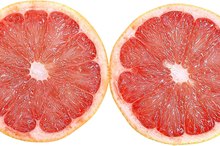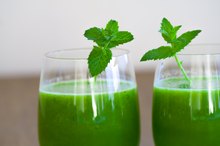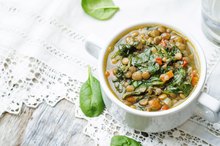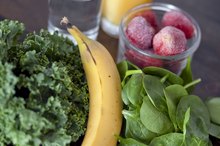What does fact checked mean?
At Healthfully, we strive to deliver objective content that is accurate and up-to-date. Our team periodically reviews articles in order to ensure content quality. The sources cited below consist of evidence from peer-reviewed journals, prominent medical organizations, academic associations, and government data.
The information contained on this site is for informational purposes only, and should not be used as a substitute for the advice of a professional health care provider. Please check with the appropriate physician regarding health questions and concerns. Although we strive to deliver accurate and up-to-date information, no guarantee to that effect is made.
Oatmeal Vs. Green Smoothies for Breakfast
Whether you choose to eat oatmeal or drink a green smoothie for breakfast, you get a healthy mixture of nutrients, vitamins and minerals and a metabolic boost. Neither is clearly better than the other, but it does help to learn more about the merits and potential downsides of each before you choose one to be your morning mainstay.
Benefits
A healthy breakfast in the form of a nutrient-packed smoothie or filling bowl of oatmeal does more than just get you through to lunch. According to MayoClinic.com registered dietitian Katherine Zeratsky, a balanced morning meal prevents overeating, puts you on track to make other healthy choices and can even spur you to be more physically active throughout the day 1.
Nutrition Facts
How Can Oatmeal Help You to Lose Weight?
Learn More
According to the USDA, a cup of cooked oatmeal has approximately 165 calories, 6 g of protein, 3.5 g of fat, 28 g of carbohydrates, 4 g of fiber and 0.5 g of sugar. Green smoothies can vary widely in nutritional content based on what they contain, but a 12 oz. green smoothie with both leafy greens and fruit has about 130 calories, 1 g of fat, 30 g of carbohydrates, 5 g of fiber and 5 g of protein.
Composition
The foundation of a healthy diet is variety, which includes getting regular servings from each major food group. Oatmeal is a whole grain, and if you serve it with milk and fresh fruit, you can cover three of the five major groups with your breakfast. Putting at least a full serving of vegetables and fruits in a green smoothie covers two groups, and you can squeeze in a third if you blend the ingredients with low-fat milk or yogurt.
Filling Up
How to Add Raw Egg to Soup
Learn More
Your breakfast should contain enough calories and healthy nutrients to keep you satisfied until your next main meal, especially if you don’t have time to grab a snack at mid-morning. “Cooking Light” magazine registered dietitian Holley Johnson Grainger notes that the best breakfasts balance fiber-rich carbohydrates, lean protein and healthy fat to keep you full. On its own, oatmeal has enough of each component, but a green smoothie runs short on fat and protein without a dairy ingredient added. Fiber-rich foods such as oatmeal take longer to chew and eat. If you can drink a green smoothie quickly, it may take longer for your brain to send a fullness signal to your body, and you may end up taking in more calories than you need.
- Your breakfast should contain enough calories and healthy nutrients to keep you satisfied until your next main meal, especially if you don’t have time to grab a snack at mid-morning.
- “ On its own, oatmeal has enough of each component, but a green smoothie runs short on fat and protein without a dairy ingredient added.
Considerations
Green smoothies and oatmeal are both healthy morning choices, so it’s wise to look at the rest of your diet when you choose one. If you tend to eat a lot of whole grains at other meals, try getting in some fruits and veggies with a smoothie in the morning. Alternately, if you munch on fresh produce at other points during the day, use breakfast to get an extra serving of whole grains with oatmeal.
Related Articles
References
- MayoClinic.com; Breakfast: Why Is It So Important to Weight Control?; Katherine Zeratsky, R.D., L.D.; July 25, 2009
- CookingLight.com; Eat Breakfast Daily; Holley Johnson Grainger, R.D., M.S.; 2011
- Henning SM, Yang J, Shao P, et al. Health benefit of vegetable/fruit juice-based diet: Role of microbiome. Sci Rep. 2017;7(1):2167. doi:10.1038/s41598-017-02200-6
- McCartney D, Rattray M, Desbrow B, Khalesi S, Irwin C. Smoothies: Exploring the Attitudes, Beliefs and Behaviours of Consumers and Non-Consumers. Current Research in Nutrition and Food Science Journal. 2018;6(2):425-436. doi:10.12944/crnfsj.6.2.17
- "Detoxes" and "Cleanses": What You Need to Know. National Center for Complementary and Integrative Health. Updated September 17, 2019.
- Protein in diet. U.S. National Library of Medicine. Reviewed April 30, 2019.
- How much sugar is too much? American Heart Association.
- Appendix 2. Estimated Calorie Needs per Day, by Age, Sex, and Physical Activity Level. Office of Disease Prevention and Health Promotion Dietary Guidelines 2015-2020. Published 2015.
Writer Bio
Carly Schuna is a Wisconsin-based professional writer, editor and copy editor/proofreader. She has worked with hundreds of pieces of fiction, nonfiction, children's literature, feature stories and corporate content. Her expertise on food, cooking, nutrition and fitness information comes from a Level 1 personal training certification and years of in-depth study.
